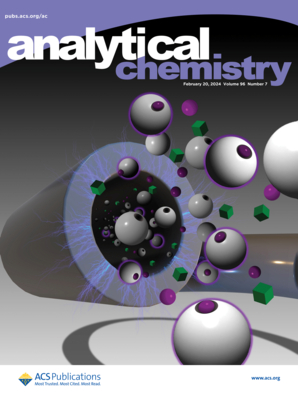二维异光谱相关分析利用激发-发射矩阵和紫外光谱阐明了河流溶解有机物的光降解途径。
IF 6.7
1区 化学
Q1 CHEMISTRY, ANALYTICAL
引用次数: 0
摘要
水生环境中溶解有机物(DOM)的光降解不仅会改变微生物组成的变化,还会改变光谱指纹图谱,从而降低追溯的准确性。在为期12天的光降解实验中,利用荧光激发发射矩阵光谱(EEMs)研究了典型源(即羊粪便(EXC)、城市污水(URB)、石化废水(IND)和河岸表土(tDOM))对DOM荧光特性的光降解影响。共鉴定出6种组分(C1-C6): C1:木质素衍生中间体,C2:类色氨酸,C3:类黄腐酸,C4/C6:类酪氨酸,C5:光降解副产物。有趣的是,C1、C4和C6在EXC/IND-DOM中占主导地位,C5在tDOM中占主导地位,C2在URB中占主导地位。基于异质二维相关光谱(EEMs-UV)和移动窗口(MW)分析,我们发现ex - dom和tDOM中的类蛋白和IND-DOM中含有酚类、芳香族和醇羟基的类胺类蛋白是光敏的,在光降解过程中0-4天深度分解,而URB-DOM中的类蛋白是持续分解的。此外,在ec - dom、URB-DOM和tDOM降解过程中,木质素衍生物在0 ~ 2 d内迅速分解。根据结构方程模型,ex - dom中的蛋白样蛋白可通过C5间接深度降解,而IND、URB和tDOM中的蛋白样蛋白可直接降解。此外,木质素衍生物可直接在EXC、tDOM和URB中分解。这些发现不仅揭示了不同来源DOM的光降解机理,而且有助于在自然水体和工程水体中进行追溯。本文章由计算机程序翻译,如有差异,请以英文原文为准。
Two-Dimensional Heterospectral Correlation Analysis Elucidates Photodegradation Pathways of Riverine Dissolved Organic Matter Using Excitation-Emission Matrix and Ultraviolet Spectroscopy.
Photodegradation of dissolved organic matter (DOM) in aquatic environments can alter spectral fingerprints beyond microbial composition changes, which reduces traceback accuracy. Here, photodegradation effects on the fluorescence properties of DOM from typical sources were investigated using fluorescence excitation-emission matrix spectroscopy (EEMs), i.e., sheep excrement (EXC), urban sewage (URB), petrochemical wastewater (IND), and riparian topsoil (tDOM), over a 12-day photodegradation experiment. Six components (C1-C6) were identified: C1: lignin-derived intermediates, C2: tryptophan-like, C3: fulvic-like, C4/C6: tyrosine-like, and C5: photodegradation byproducts. Interestingly, C1, C4 and C6 dominated in EXC/IND-DOM, C5 in tDOM, and C2 in URB. Based on hetero-2D correlation spectroscopy (EEMs-UV) and moving window (MW) analysis, we found that protein-like in EXC-DOM and tDOM and amine-like in IND-DOM containing phenolic, aromatic, and alcoholic-hydroxyl are photosensitive and deeply decompose in 0-4 days during the photodegradation, while protein-like in URB-DOM is continuously decomposed. Moreover, lignin-derived was rapidly decomposed in 0-2 days during the EXC-DOM, URB-DOM, and tDOM degradation. According to the structural equation model, protein-like in EXC-DOM could be deeply degraded indirectly through C5, whereas that in IND, URB and tDOM might be directly degraded. Furthermore, lignin-derived might be directly decomposed in EXC, tDOM, and URB. These findings not only reveal the photodegradation mechanism of DOM from different sources but also are conducive to traceability in natural and engineered water bodies.
求助全文
通过发布文献求助,成功后即可免费获取论文全文。
去求助
来源期刊

Analytical Chemistry
化学-分析化学
CiteScore
12.10
自引率
12.20%
发文量
1949
审稿时长
1.4 months
期刊介绍:
Analytical Chemistry, a peer-reviewed research journal, focuses on disseminating new and original knowledge across all branches of analytical chemistry. Fundamental articles may explore general principles of chemical measurement science and need not directly address existing or potential analytical methodology. They can be entirely theoretical or report experimental results. Contributions may cover various phases of analytical operations, including sampling, bioanalysis, electrochemistry, mass spectrometry, microscale and nanoscale systems, environmental analysis, separations, spectroscopy, chemical reactions and selectivity, instrumentation, imaging, surface analysis, and data processing. Papers discussing known analytical methods should present a significant, original application of the method, a notable improvement, or results on an important analyte.
 求助内容:
求助内容: 应助结果提醒方式:
应助结果提醒方式:


